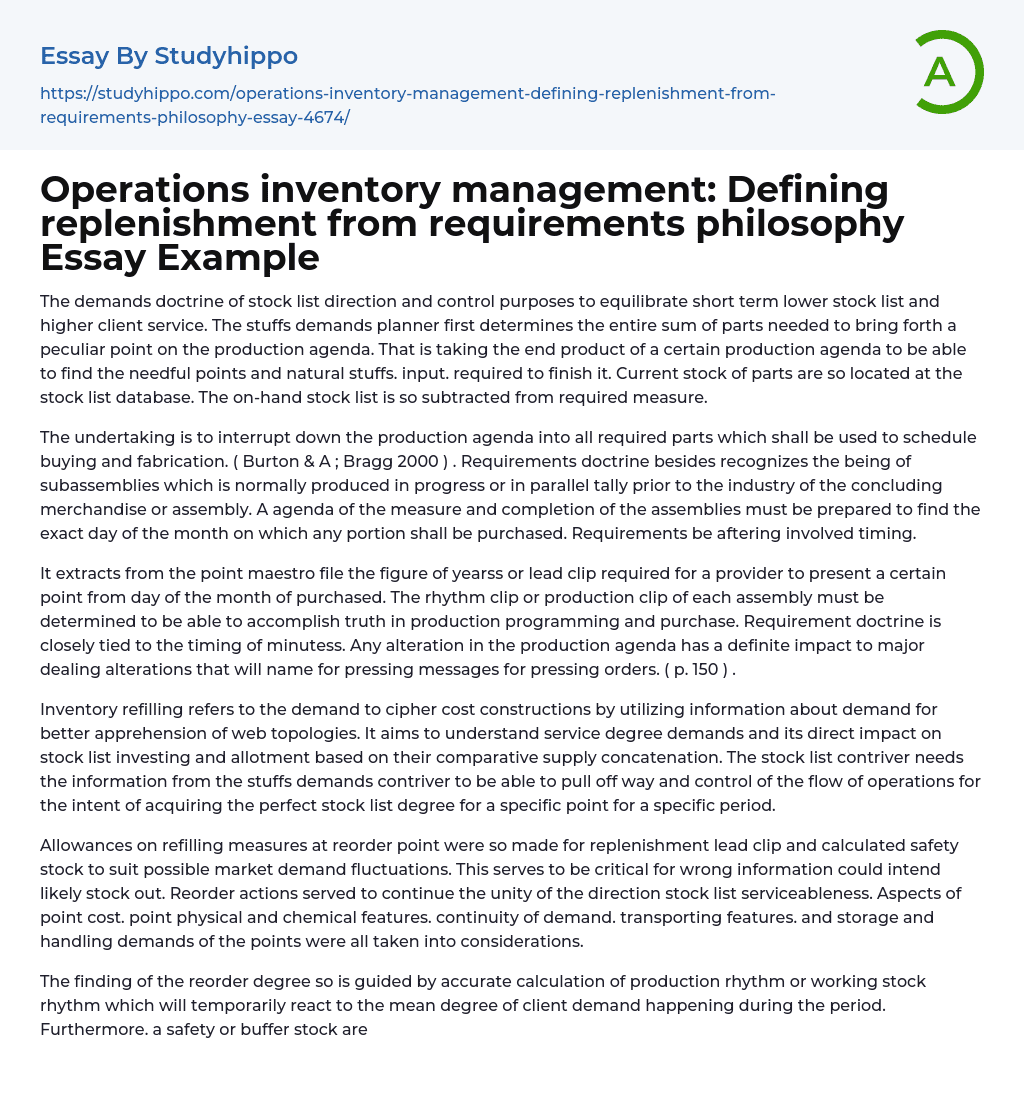

Operations inventory management: Defining replenishment from requirements philosophy Essay Example
The purpose of the demands doctrine in stock list management and control is to balance short-term lower stock levels and higher customer service. The materials demands planner first calculates the total amount of parts needed to produce a specific item on the production schedule. This is done by determining the required components and raw materials input needed to complete it. The current stock of parts is then located in the inventory database, and the on-hand inventory is subtracted from the required quantity. The goal is to break down the production schedule into all necessary parts that will be used for purchasing and manufacturing (Burton & Bragg, 2000).
The requirements doctrine also takes into account the existence of subassemblies, which are typically produced in advance or in parallel before the final product or assembly is manufactured. A schedule for the quantit
...y and completion of these assemblies must be prepared to determine the exact date on which any part should be purchased. Requirements planning involves timing, as it references the number of days or lead time required for a supplier to deliver a specific item from the date of purchase, which helps determine the production or cycle time of each assembly. This ensures accuracy in production scheduling and purchasing. The requirements doctrine is closely linked to transaction timing.Any changes to the production schedule will have a direct impact on major business changes, which will require urgent communication regarding urgent orders. Inventory replenishment involves using data on demand to analyze cost structures and better understand network topologies. It aims to determine the level of service required and how it directly affects inventory investment and allocation based on the
supply chain. The inventory planner relies on information from the materials demand planner to manage operations and control the flow for the purpose of achieving the optimal inventory level for a specific item and timeframe. Adjustments are then made to reorder points, replenishment lead times, and safety stock calculations to accommodate potential fluctuations in market demand to prevent stockouts. Reorder actions are necessary to ensure the overall effectiveness of inventory management. Factors such as item cost, physical and chemical attributes, continuity of demand, transportation characteristics, and storage and handling requirements are all carefully considered. The reorder level is determined through accurate calculations of production or working stock cycles that respond temporarily to the average customer demand during the period. Additionally,A safety or buffer stock is set up to account for variations in demand. This is done by adding allowances or extra stock to the regular stock level in case there is a discrepancy in the distribution of demand (Ross, 1996). The distinction between the demands doctrine and replenishment doctrine lies in their focus. The demands doctrine ensures that specific demands are met for production, while the replenishment doctrine takes into account external factors such as cost, lead time, transportation, and storage requirements for the item being considered. This is determined by specifying a reorder level for each item or material, with careful consideration of the availability of demand and supply.
- Chief Executive Officer essays
- Convenience Store essays
- Firm essays
- Training And Development essays
- Unilever essays
- Variable Cost essays
- Virgin Group essays
- Bargaining essays
- Entity essays
- Pest analysis essays
- Age Of Enlightenment essays
- Ethos essays
- Time essays
- Acceptance essays
- Meaning Of Life essays
- Reality essays
- Natural Law essays
- Political Philosophy essays
- Utilitarianism essays
- Existence essays
- Free Will essays
- Good And Evil essays
- Confucianism essays
- Relativism essays
- Conscience essays
- Environmentalism essays
- Empiricism essays
- Epistemology essays
- Ethics essays
- Existentialism essays
- Human Nature essays
- Individualism essays
- Metaphysics essays
- Philosophy Of Life essays
- Transcendentalism essays
- Truth essays
- Destiny essays
- Determinism essays
- Fate essays
- Functionalism essays
- Philosophers essays
- Pragmatism essays
- Future essays
- Child Observation essays
- Critical Reflection essays
- Teaching Philosophy essays
- Personal Philosophy essays
- Action Speak Louder Than Words essays
- Can Money Buy Happiness essays
- Values of Life essays



